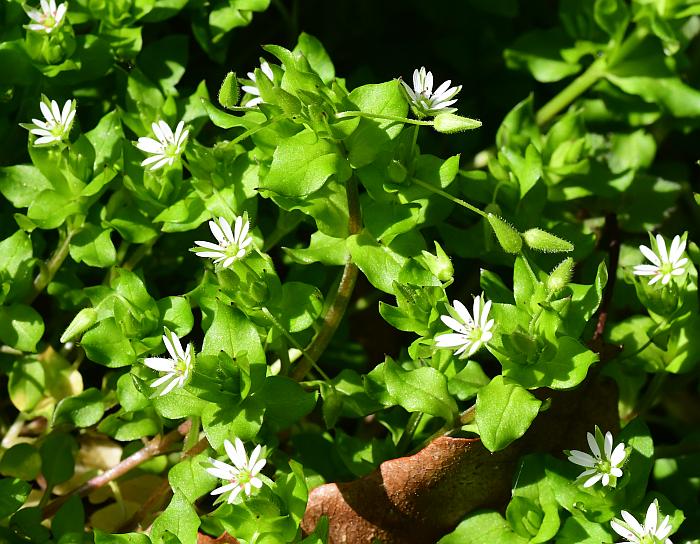Stellaria media (L.) Vill.
Common Chickweed

Introduced
CC = *
CW = 3
MOC = 58
© SRTurner
Stellaria media (L.) Vill.Common Chickweed | |
 |
Introduced CC = * CW = 3 MOC = 58 |
© SRTurner |
|
Family - Caryophyllaceae Habit - Annual or short-lived perennial forb. Stems - Spreading to erect or decumbent, to 80 cm, branched, somewhat succulent, usually short-hairy in longitudinal lines, rarely nearly glabrous.
Leaves - Opposite, petiolate near base, sessile upward. Leaf blades 0.3-4.0 cm long, ovate to elliptic, rounded to nearly truncate at the base, angled or slightly tapered at the tip, glabrous, green above, lighter green below, entire, the margins glabrous or inconspicuously hairy.
Inflorescence - Terminal clusters or sometimes solitary, the stalks 0.3-4.0 cm long, pubescent, ascending at flowering, often angled downward from the base at fruiting, the bracts herbaceous and resembling small leaves. Flowers - Sepals 5, 4.0-4.5 mm long, oblong-lanceolate, lacking a reddish band at the base, bluntly pointed at the tip, the margins thin and white, finely hairy. Petals 5, deeply notched and appearing as 10, occasionally absent, 1-4 mm long, shorter than to about as long as the sepals, glabrous, free. Stamens typically 3-5, alternating with petals.
Fruits - Capsules 4-6 mm long, 4 mm wide, ovoid, glabrous, dehiscing via 6 apical teeth, with about 15 seeds. Seeds 0.9-1.4 mm wide, the surface tuberculate, the tubercles along the marginal portion broader than tall, more or less hemispherical, blunt or rounded at the tip, brown to reddish brown.
Flowering - Typically March - November, but can flower all year. Habitat - Streambanks, bases and ledges of bluffs, sloughs, forests, pastures, crop fields, fallow fields, ditches, lawns, gardens, roadsides, and disturbed areas. Origin - Native to Eurasia. Lookalikes - S. neglecta, S. pallida; more broadly, some species of Cerastium. Other info. - This plant is probably found in every Missouri county and is very common in most places. It is one of the most successful weeds in the world, being found across the globe. It is easily recognized by its prostrate, mat-forming habit and small white flowers with deeply cleft petals. The plant does show a wide range of morphological expression and can sometimes be difficult to distinguish from its lookalikes. Photographs taken in Gainesville, FL., 2-16-03, and in Auburn, AL., 3-19-05 (DETenaglia); also along the Katy Trail near Marthasville, Warren County, MO, 3-25-2020, and along the Katy Trail near Dutzow, Warren County, MO, 4-22-2020 (SRTurner). |